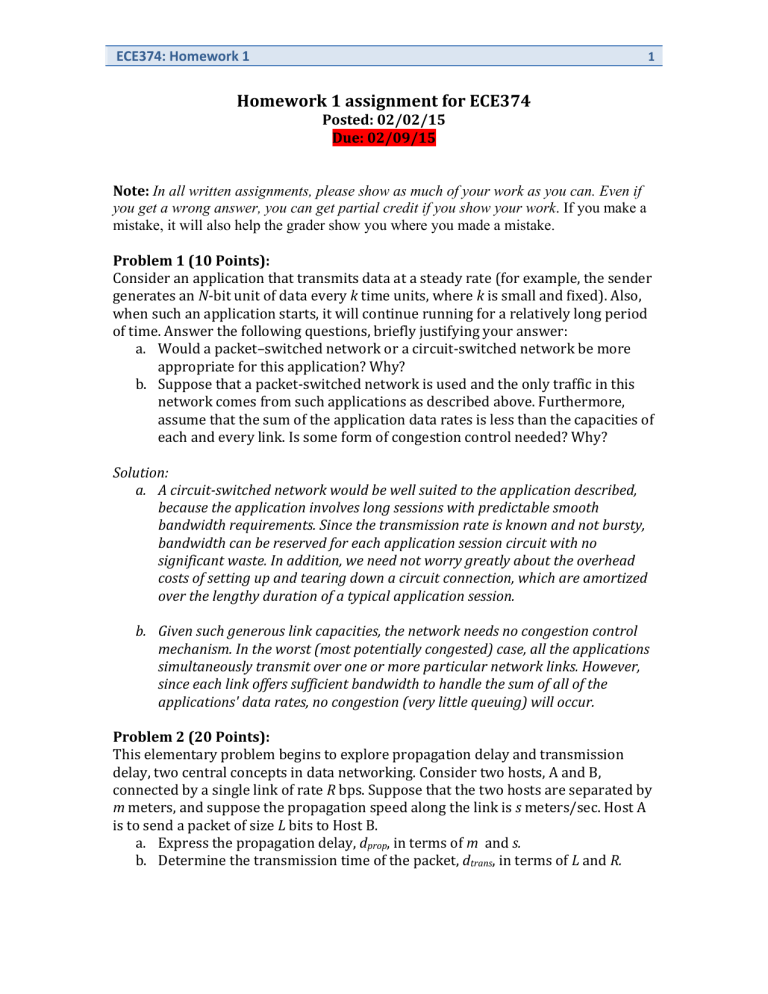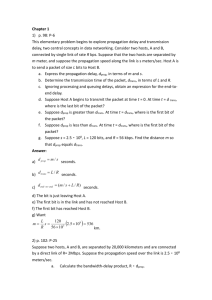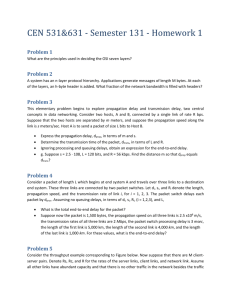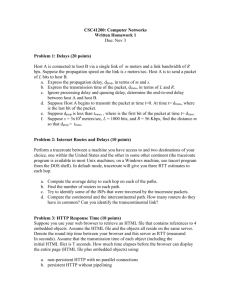
ECE374: Homework 1 1 Homework 1 assignment for ECE374 Posted: 02/02/15 Due: 02/09/15 Note: In all written assignments, please show as much of your work as you can. Even if you get a wrong answer, you can get partial credit if you show your work. If you make a mistake, it will also help the grader show you where you made a mistake. Problem 1 (10 Points): Consider an application that transmits data at a steady rate (for example, the sender generates an N-­‐bit unit of data every k time units, where k is small and fixed). Also, when such an application starts, it will continue running for a relatively long period of time. Answer the following questions, briefly justifying your answer: a. Would a packet–switched network or a circuit-­‐switched network be more appropriate for this application? Why? b. Suppose that a packet-­‐switched network is used and the only traffic in this network comes from such applications as described above. Furthermore, assume that the sum of the application data rates is less than the capacities of each and every link. Is some form of congestion control needed? Why? Solution: a. A circuit-­‐switched network would be well suited to the application described, because the application involves long sessions with predictable smooth bandwidth requirements. Since the transmission rate is known and not bursty, bandwidth can be reserved for each application session circuit with no significant waste. In addition, we need not worry greatly about the overhead costs of setting up and tearing down a circuit connection, which are amortized over the lengthy duration of a typical application session. b. Given such generous link capacities, the network needs no congestion control mechanism. In the worst (most potentially congested) case, all the applications simultaneously transmit over one or more particular network links. However, since each link offers sufficient bandwidth to handle the sum of all of the applications' data rates, no congestion (very little queuing) will occur. Problem 2 (20 Points): This elementary problem begins to explore propagation delay and transmission delay, two central concepts in data networking. Consider two hosts, A and B, connected by a single link of rate R bps. Suppose that the two hosts are separated by m meters, and suppose the propagation speed along the link is s meters/sec. Host A is to send a packet of size L bits to Host B. a. Express the propagation delay, dprop, in terms of m and s. b. Determine the transmission time of the packet, dtrans, in terms of L and R. c. Ignoring processing and queuing delays, obtain an expression for the end-­‐to-­‐ end delay. d. Suppose Host A begins to transmit the packet at time t=0. At time t=dtrans, where is the last bit of the packet? e. Suppose dprop is greater than dtrans. At time t=dtrans, where is the first bit of the packet? f. Suppose dprop is less than dtrans. At time t=dtrans, where is the first bit of the packet? g. Suppose s=2*109, L=1024 bits, and R=256 kbps. Find the distance m so that dprop equals dtrans. Solution: d prop = m / s a. seconds. b. d trans = L / R seconds. c. d. e. f. g. d end −to−end = ( m / s + L / R ) seconds. The bit is just leaving Host A. The first bit is in the link and has not reached Host B. The first bit has reached Host B. Want L 1024 m= s= 2 ×10 9 ) = 8000 km. 3( R 256 ×10 Problem 3 (15 Points): Consider the circuit-­‐switched network shown in Figure 1. Recall that there are 4 circuits on each link. Label the switches A, B, C, and D starting at the top-­‐left corner, going on clockwise direction. a. What is the maximum number of simultaneous connections that can be in progress at any one time in this network? b. Suppose that all connections are between switches A and C. What is the maximum number of simultaneous connections that can be in progress? c. Suppose we want to make four connections between switches A and C, and another four connections between switches B and D. Can we route these calls through the four links to accomplish all eight connections? ECE374: Homework 1 3 Figure 1 Solution: a. Between the switch in the upper left and the switch in the upper right we can have 4 connections. Similarly we can have four connections between each of the 3 other pairs of adjacent switches. Thus, this network can support up to 16 connections. b. We can 4 connections passing through the switch in the upper-­‐right-­‐hand corner and another 4 connections passing through the switch in the lower-­‐left-­‐ hand corner, giving a total of 8 connections. c. Yes. For the connections between A and C, we route two connections through B and two connections through D. For the connections between B and D, we route two connections through A and two connections through C. In this manner, there are at most 4 connections passing through any link. Problem 4 (25 Points): Perform a Traceroute between your computer and www.ucsd.edu at three different hours of the day. (Add screenshots of the three Traceroutes to your answer!) a. Find the average and standard deviation of the round-­‐trip delays at each of the three hours. b. Find the number of routers in the path at each of the three hours. Did the paths change during any of the hours? c. Try to identify the number of ISP networks the Traceroute packets pass through from source to destination. Routers with similar names and/or similar IP addresses should be considered as part of the same ISP. In your experiments, do the largest delays occur at peering interfaces between adjacent ISPs? d. Repeat the above for a destination on a continent different then the source. Compare the intra-­‐ and inter-­‐continent results. Solution: There is no general solution for this problem, since this depends on the results you obtained from traceroute. Problem 5 (15 Points): Suppose you would like to urgently deliver 400 terabytes of data from Boston to Los Angeles. You have a 10 Gbps dedicated link for data transfer available. Would you prefer to transmit the data via this link or instead use FedEx overnight delivery? Explain. Solution: 40 terabytes = 40 * 1012 * 8 bits. So, if using the dedicated link, it will take 400 * 1012 * 8 / (10 *109 ) = 320000 seconds = 3.7 days. But with FedEx overnight delivery, you can guarantee the data arrives in one day, and it only costs you no more than $100. Problem 6 (15 Points): Suppose there is a 10 Mbps microwave link between a geostationary satellite and its base station on Earth. Every minute the satellite takes a digital photo and send it to the base station. Assume a propagation speed of 2.4 * 108 meters/sec. a. What is the propagation delay of the link? b. What is the bandwidth-­‐delay product, R * dprop? c. Let x denote the size of the photo. What is the minimum value of x for the microwave link to be continuously transmitting? Solution: Recall geostationary satellite is 36,000 kilometers away from earth surface a. 150 msec b. 1,500,000 bits c. 600,000,000 bits





